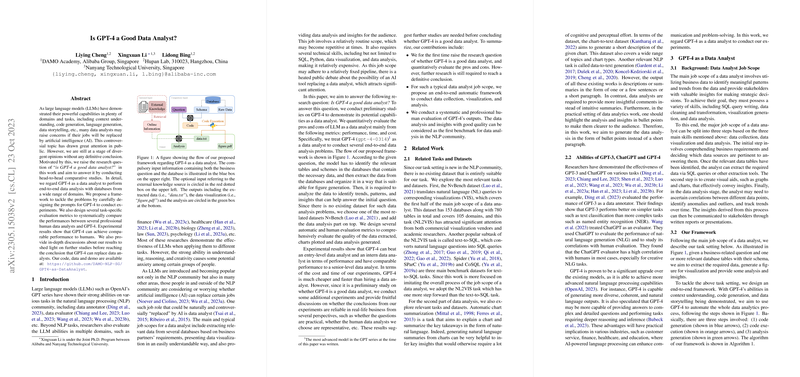Is GPT-4 a Good Data Analyst?
Introduction
The paper "Is GPT-4 a Good Data Analyst?" investigates whether GPT-4, a LLM developed by OpenAI, can perform the tasks typically undertaken by a human data analyst. The motivation behind this research stems from the increasing capabilities of LLMs across various domains and the resulting concerns about potential job displacement. The paper employs a comparative approach to evaluate GPT-4's performance against human data analysts, focusing on end-to-end data analysis tasks.
Methodology
The paper designs a comprehensive framework to simulate data analysis tasks using GPT-4. The framework encompasses:
- Code Generation: GPT-4 generates SQL queries and Python code to extract and visualize data.
- Code Execution: The generated code is executed offline to ensure data privacy.
- Analysis Generation: GPT-4 generates insights based on the extracted data, optionally integrating external knowledge sources.
The evaluation is conducted using the NvBench dataset, which contains a variety of database queries and visualizations across multiple domains. The researchers enhance the dataset by adding custom analysis tasks and evaluating GPT-4's performance against this extended benchmark.
Evaluation Metrics
The paper introduces specific evaluation metrics to assess GPT-4's performance:
- Figure Evaluation: Correctness, Chart Type, and Aesthetics.
- Data Analysis Evaluation: Correctness, Alignment, Complexity, and Fluency.
These metrics provide a comprehensive assessment of GPT-4's ability to generate accurate, aligned, and insightful data analysis.
Results
The researchers present detailed results showing that GPT-4 performs comparably to human data analysts, with certain caveats. The main findings are:
- GPT-4's ability to generate correct chart types and aesthetically pleasing visualizations is robust, but some minor errors in data correctness were noted.
- GPT-4's generated analysis is largely accurate, aligned, and fluently articulated. However, there were occasional minor inaccuracies attributed to the model's hallucination tendencies.
- In terms of complexity, GPT-4's analysis often incorporated meaningful comparisons and insights, though it sometimes lacked the nuanced thinking exhibited by experienced human analysts.
Comparison with Human Analysts
To contextualize GPT-4's performance, the paper included a comparative analysis with professional data analysts at different experience levels (senior, junior, and intern). The findings indicate that:
- GPT-4 outperformed entry-level and intern data analysts in terms of both performance and efficiency.
- GPT-4's performance is comparable to that of senior data analysts, though human experts occasionally demonstrated superior problem formulation and nuanced insights.
Furthermore, the cost and time efficiency of GPT-4 were significantly higher than human analysts, highlighting its potential as a cost-effective tool for data analysis.
Practical and Theoretical Implications
Practically, the paper suggests that GPT-4 could be a valuable asset in data analysis, particularly for routine and structured tasks. Its integration could lead to significant cost savings and efficiency improvements in industries reliant on data analytics. However, the occasional inaccuracies and lack of deep contextual insights imply that human oversight remains essential.
Theoretically, the paper contributes to understanding the limitations and potential of LLMs in practical applications beyond traditional NLP tasks. It opens avenues for further research into enhancing LLM performance, especially in tasks requiring complex reasoning and domain-specific knowledge.
Future Directions
The paper acknowledges that further research is required to conclusively determine GPT-4's capability as a data analyst. Future developments could focus on:
- Enhancing the reliability of LLMs by addressing hallucination issues and improving numerical accuracy.
- Exploring the integration of real-time external knowledge sources more systematically to bolster the model's contextual understanding.
- Investigating more open-ended, practical data analysis tasks to better mimic real-world scenarios and requirements.
Conclusion
The paper provides a nuanced view of GPT-4's capabilities as a data analyst. While GPT-4 shows promising results and competitive performance compared to human analysts, particularly in routine tasks, certain limitations highlight the need for ongoing research and human oversight. The insights gained from this paper could guide future developments in AI-driven data analysis, aiming to strike a balance between automation efficiency and the depth of human expertise.
